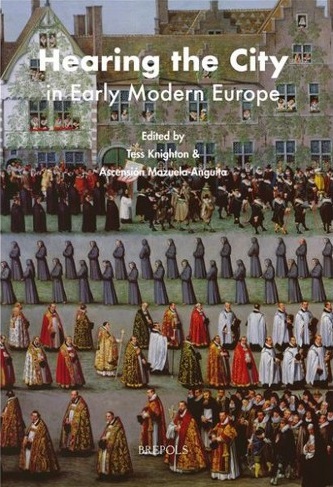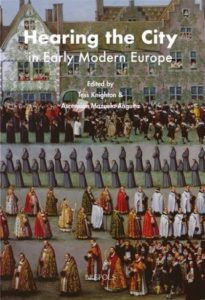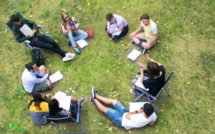
Hearing the City in Early Modern Europe edited by Tess Knighton and Ascensión Mazuela-Anguita

The study of the sonic environment of cities, including both the diverse kinds of music to be experienced there as well as other audible phenomena, has existed for some time as a focus of research. Although commonly known as “urban musicology,” this kind of study is fundamentally interdisciplinary, and of interest to scholars working in a wide variety of fields. It aims not simply to chart all that could be heard in a particular city at a particular time, but also to examine the ways in which those sounds interact with urban topography, architecture, institutions, and social groups. Hearing the City in Early Modern Europe aims to draw the disparate threads of current research on the topic together, as well as lend new impetus to future work. The book springs from a workshop held in Barcelona in 2015 that was part of a Marie Curie Foundation project entitled “Urban Musics and Musical Practices in Sixteenth-Century Europe,” led by one of the book’s co-editors.[1] It gathers twenty-one essays from scholars in disciplines including musicology, history, history of literature, and art history in a methodologically wide-ranging collection covering both Europe and beyond from the fifteenth to the eighteenth centuries. As a wide readership is envisaged, music-technical vocabulary and musical notation are largely avoided.
An introduction and coda frame nineteen essays arranged in four thematic groups (“Crossing Boundaries,” “Sounds in Contention,” “Soundworlds and Spatial Strategies of the Social Elite,” and “Case Studies in Urban Soundscapes”). Across these divisions, three dominant themes emerge, which can be taken as a barometer of current concerns: attention to the sensory experience of early modern hearers and listeners; a more nuanced understanding than hitherto of primary source materials; and the use of sound in relation to identity and representation. These themes resonate throughout the book, and are frequently simultaneously present in individual contributions.
Tim Carter’s introduction is a pendant to the same author’s 2002 manifesto for urban musicology.[2] It offers an ideal starting-point for understanding both what urban musicology in general sets out to achieve, as well as the concerns of the book more specifically. Noting the surprising lack, in some earlier studies, of engagement with music as sound, Carter’s chapter observes the recent “acoustic turn,” which attempts to come to terms with listeners’ sensory experience. Such experience is by definition extremely difficult to grasp. Nonetheless, using evidence from early seventeenth-century Italy, Carter shows that much more can be achieved than is currently the case. Not content to leave the discussion at a purely theoretical level, he also offers a practical demonstration, with a potential period hearing of Giovanni Gabrieli’s well-known motet In ecclesiis.[3] The attempt is plainly hypothetical in nature, but nonetheless inspiring.[4] Sensory experience also dominates the contributions of Jan-Friedrich Missfelder and Joachim Kremer. Both deal with moral and ethical concerns around music. In Missfelder’s case, the notoriously hostile environment of Reformation Zurich offers a chance to revise current narratives about the sensory value of sound—and silence—as a medium for devotion. Kremer takes the debate surrounding opera in Hamburg in the eighteenth century as a potential danger to civic morality. Peter Holman’s contribution, too, connects to experience in tracing the developing use of large vocal and instrumental groups in early eighteenth-century London. He makes the important point that the distinctive spatial arrangement of performers in the eighteenth century meant that the experience of listening to such ensembles was quite different from performances today, including those that claim historical authenticity.
Like Carter’s introduction, the chapter that begins the main body of the book, by Dinko Fabris, also offers useful orientation for those who may not be familiar with urban musicology, by documenting the history of the approach, surveying relevant literature, and outlining its current state. The twin issues of what source materials to use, and how they should be interpreted, frequently take center-stage thereafter. Using the ceremonial entry of James I into London on March 15, 1604 as a case study, Bruce R. Smith demonstrates how the surviving documents present an idealized account of a reality in which sound might have been used not only as a ceremonial ornament but also as a means of disruption or transgression. Similar issues are raised by Ferrán Escrivà-Llorca, who also charts a procession through a city’s streets—in his case the translation of the relics of Saint Rochus in Lisbon in 1588. Andrea Bombi focusses on the narrative strategies in descriptions of festive events in the chronicles of Valencian Dominican houses as indicators of experience and identity-construction. The fact that the documents do not always accurately describe how the events must have been is less important than their representational value and their plausibility. Tess Knighton offers a particularly elegant reading of documents not often used in musicology—a catechism, inquisition records, traveler’s accounts, and notarial records—to uncover the unwritten musical practices of marginalized social groups in sixteenth-century Barcelona. Anna Tedesco, in her chapter on the city of Palermo, considers the value to soundscape studies of visual sources.
The third dominant theme, the representative functions of sound, takes a number of forms. Helen Hills and Ascensión Mazuela-Anguita concern themselves with its relationship to gender in two contrasting cases. For Hills, the baroque convent offers an opportunity to consider the tension between architecture, which serves to separate the nuns from the wider world, and sound, by which the nuns could project themselves beyond physical barriers. The Requesens palace in Barcelona, considered by Mazuela-Anguita, was a de facto primarily female space due to the continued absence of its male occupants. As an interface between private and public, it served as an arena by which the palace’s noblewomen could consolidate their social status. Juan José Carreras and Reinhard Strohm, treating Madrid and Vienna respectively, address cities as overlapping networks in which sounds serve to articulate social structures and community organization. The effects of representation could also have an impact on the layout of the city itself. Buildings, such as the Palazzo Orsini in Rome studied by Anne-Madeleine Goulet and the Sacra Capilla in the unique urban space of the town of Úbeda studied by Javier Marín-López, provided not simply a venue for music-making, but actively stimulated assertions of power including in the sonic domain. In Palermo, as discussed by Ilaria Grippaudo, the ancient city was significantly redesigned in the early seventeenth century according to Baroque notions that urban layout should reflect social hierarchies. The result was a kind of open-air theatre within which individual groups could assert their status during public events. Mélanie Traversier shows, in the case of opera houses, how the practical considerations of safety and accessibility required space around the buildings that could cause them to take on monumental urban forms.
While most of the essays focus on specific places, two deal with larger geographical areas. María Gembero-Ustárroz examines the region of Navarre, absorbed into Spain in the early sixteenth century. The region has been almost entirely neglected due to the dominance of larger urban centers elsewhere, but Gembero-Ustárroz successfully shows that size does not always correlate with importance: far from being empty, the region was home to flourishing musical practices, and well connected to wider international networks. At a yet broader scale, taking colonial cities joined by seafaring networks, David Irving shows that the early modern world was much more interlinked at a global level than often realized. Colonial cities, in places as far-flung as Australia, the Far East, India, and South America, served as crucibles of social interchange. There, European musical products were not only exported, but also were altered by their encounters with non-European cultures.
An objective of the Marie Curie project behind the publication was to stimulate the use of digital tools both for research and public engagement. Accordingly, the book’s final chapter presents an online platform, developed by Juan Ruiz Jiménez and Ignacio José Lizarán Rus, that aims to present urban soundscapes holistically.[5] Capitalizing on the advantages of the digital medium, the platform presents early modern maps of Seville and Granada, coupled to historical information, pictures, films, sound-clips, and even a number of itineraries that anyone fortunate enough to actually be those cities can follow. Hearing the City is thus a major contribution at several levels. It re-addresses existing literature from different perspectives as well as covers cities and material not previously treated. Methodologically it both captures current trends as well as stimulates future research. It is accessibly written and beautifully produced. As such, it should be of major interest to all scholars and students, whatever their discipline, who are concerned with the embedding of sonic phenomena within the urban fabric.
Reviewed by David J. Burn, University of Leuven
Hearing the City in Early Modern Europe
Edited by Tess Knighton and Ascensión Mazuela-Anguita
Paperback / 428 pages / 2018
Publisher: Brepols
ISBN: 978-2-503-57959-7
References
[1] See https://urbanmusics.wordpress.com/.
[2] “The Sound of Silence: Models for an Urban Musicology,” Urban History 29/1 (2002), 8–18; https://doi.org/10.1017/S0963926802001025.
[3] Recordings are easily available online, e.g. https://www.youtube.com/watch?v=v5VoKAoj8AE (accessed 4 February 2019).
[4] For a similar attempt for music of the fifteenth century, see Jesse Rodin, “Form and Experience in Fifteenth-Century Music: Problems, Fallacies, New Directions”, Journal of the Alamire Foundation 8 (2016), 277–94, available online at https://www.brepolsonline.net/doi/abs/10.1484/J.JAF.5.111882.
[5] http://www.historicalsoundscapes.com/en.
To read more book reviews click here.
Published on April 2, 2019.




